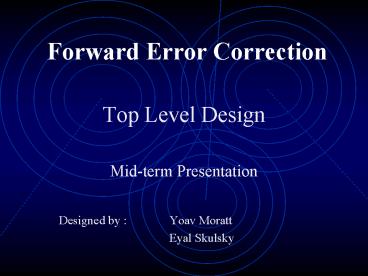Forward Error Correction - PowerPoint PPT Presentation
1 / 20
Title:
Forward Error Correction
Description:
Forward Error Correction. Top Level Design. Mid-term Presentation. Designed by : Yoav Moratt ... Assume one server needs to send 100 datagrams to 100 clients. ... – PowerPoint PPT presentation
Number of Views:162
Avg rating:3.0/5.0
Title: Forward Error Correction
1
Forward Error Correction
- Top Level Design
- Mid-term Presentation
- Designed by Yoav Moratt
- Eyal Skulsky
2
Motivation
- Multi-cast the ability to send data over the
internet to a large number of users, sets extreme
challenges in the field of protocol. - The model for this project is a server that sends
a large amount of data to many users that are not
synchronized with each other. This simulates the
common situations in the real world like internet
video streams (T.V., movies and lectures), large
databases transfer etc.
3
Motivation
- Since multicast protocols are layered over UDP
and not TCP, losses are frequent and are not
dealt with by the transport protocol. This sets
the main challenge in multicast.
4
Motivation
- The first protocol that was suggested was an
expansion of TCP for multicast. In other words
every client sends an ACK for every packet, and
the server sends the missed packets when it
doesnt get an ACK. - The problems here are obvious, many ACK packets
increase the load on the network, the server is
busy maintaining a large database with client
information.
5
Motivation
- The second suggestion was to decrease the
network load by sending NACK packets when packets
are lost. This is certainly an improvement but it
does not solve all the problems.
6
Motivation
- Assume one server needs to send 100 datagrams to
100 clients. Loss rate is 10 and clients start
at the same time (for simplicity). This example
will help us understand the difficulties and the
challenges.
7
Motivation
- In this case, each client will lose 10 datagrams,
- The server has to resend them all to the clients,
since most likely they did not all lose the same
packets, the server will have to send all the 100
packets of information again !
8
Motivation
- The Forward Error Correction solves all these
problems and also solves other problems that
originate from general server-clients relations. - The Idea is to add redundancy to the data, in
order to allow the client to restore lost
packets. Due to the redundancy the client may
lose a few packets and still be able to
reconstruct the data from the other packets!
9
Motivation
- Example
- Assume loss rate of 1/9, for every 8 packets, the
server sends a ninth packet with the XOR of the
former 8 packets. Every client gets 8 packets
(lost one). If it got the first 8, it uses them,
else the missing packet is a simple XOR between
all the rest. - This means that the server sent only 10 more
information to achieve the goal !!
10
Motivation
- Forward Error Correction Advantages
- Scalability nether the network load nor the
server load is dependent of the number of users
!!! - Robustness since the server is stateless (does
not keep track of clients), if it crashes,
recovery is a simple reboot. - Availability the server is always available at
any time, the clients are not supposed to be
synchronized, so clients may start accumulating
packets at will.
11
Project Goal
- In this project, the goal is to create a reliable
simulation for FEC protocol that will bring all
the above advantages to test. We will try to
prove that this protocol is indeed the beginning
of a new Era in the field of multicast.
12
General Configuration
In order to simplify the workspace and to gain
control of loss rate parameter, we decided that
all the clients will reside on the same machine
as the server and loss rate will be simulated by
discarding packets randomly. The project will be
run over the java virtual machine, (Operating
system invariant).
13
The project consists 6 major modules
- Server Application
- Server UI module
- FEC encoder
- Client Application
- Client UI module
- FEC decoder
- Network simulator
- Result analyzer
14
General Structure
Server User Interface
Client User Interface
Client User Interface
Client User Interface
Client User Interface
Server Application
Client Application
Client Application
Client Application
Client Application
FEC encoder
FEC decoder
FEC decoder
Noisy Network Simulator
FEC decoder
FEC decoder
15
Server Application
- This module accepts commands from its UI, to
perform the following actions - Open new Client.
- Set loss rate.
- Send data to clients.
16
Client Application
- This module reports to its UI, and performs the
following actions - Receive data from server.
- Store data for later analysis.
17
FEC encoder/decoder
This module handles the FEC encoding/decoding
18
Network simulation
- This module simulates a noisy network by
discarding packets randomly, according to the
simulated loss rate.
19
Result analyzer
- This module holds a set of functions that allow
storing the data in a file using comma separated
format for later analysis.
20
Time Table
- Week 12 Final Presentation
- Week 13-14 end of Coding Testing
- A.S.A.P submission of final results and
documentation.































